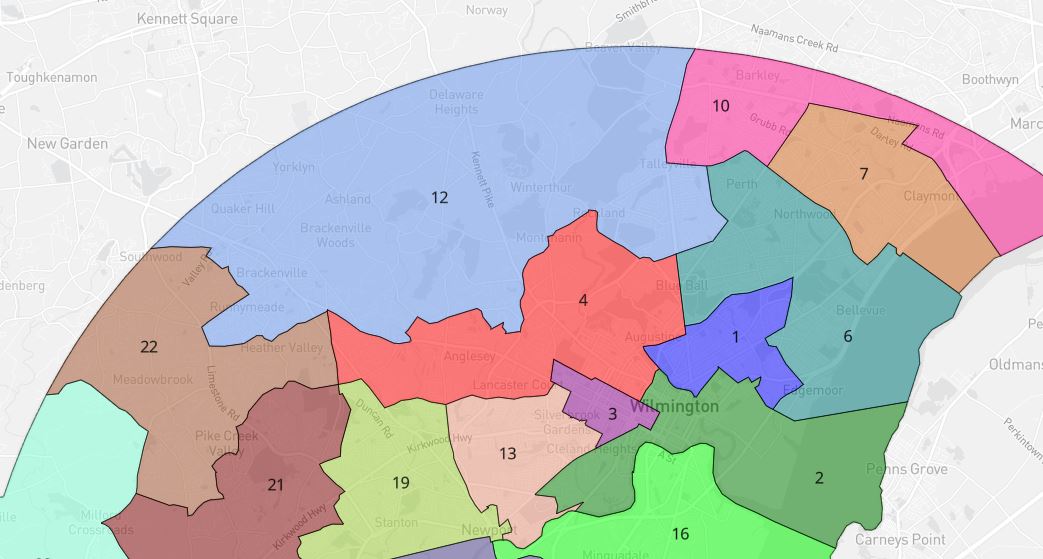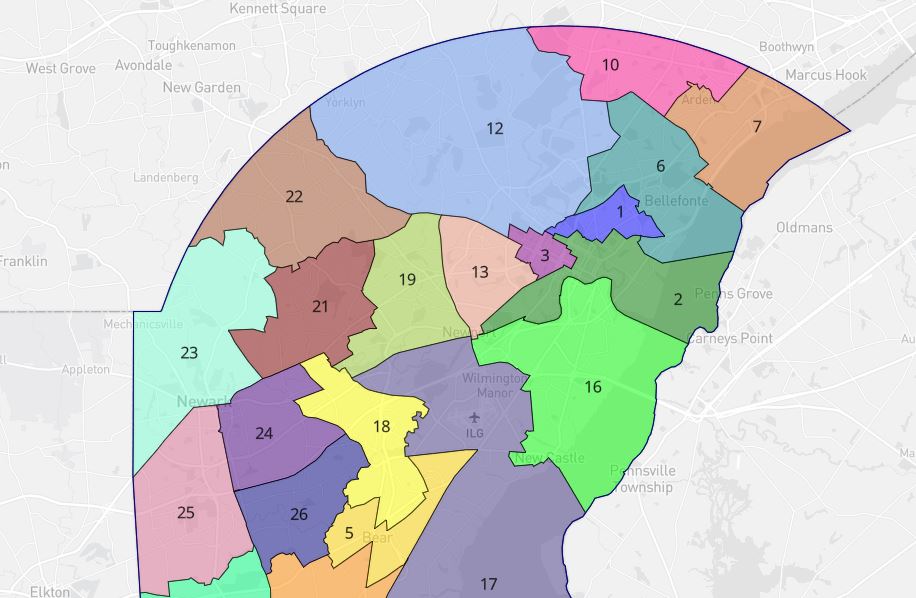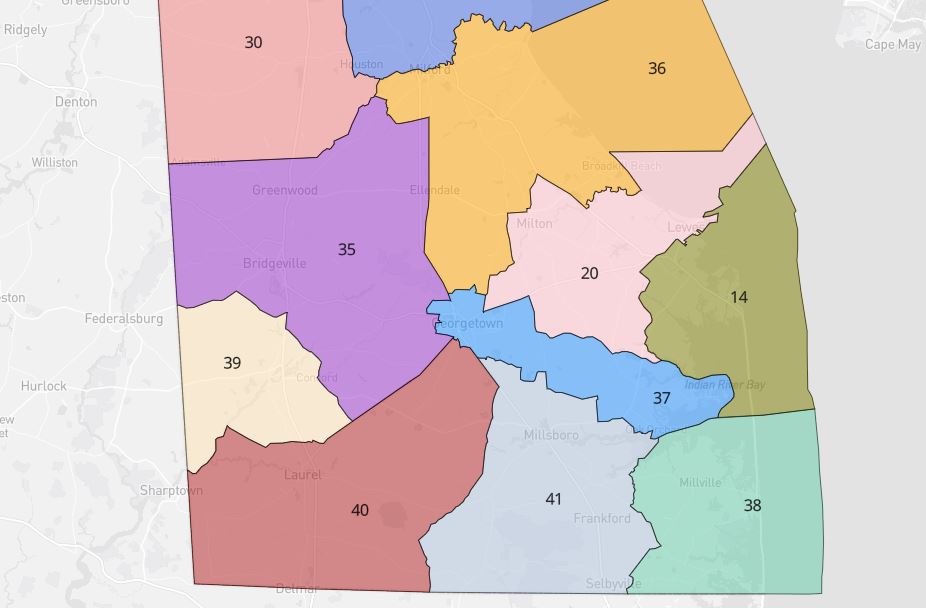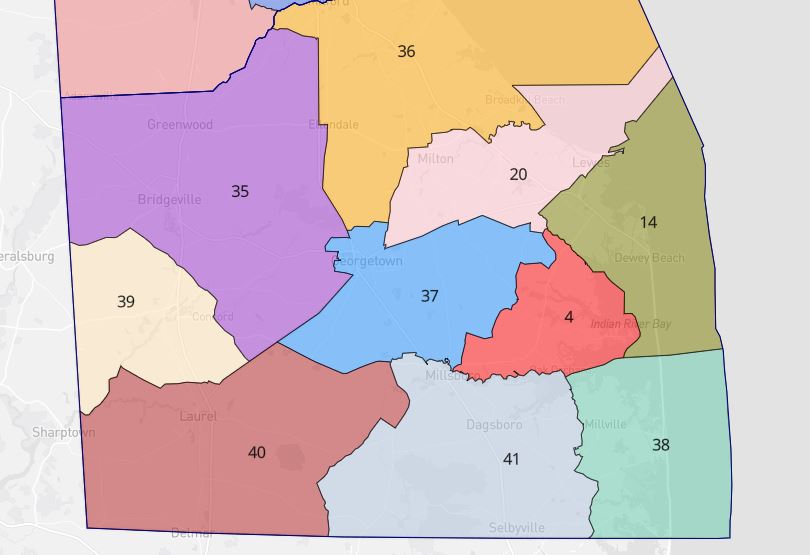This is the second of three parts.
As noted in my first part, Delaware Democrats had a problem in redistricting – according to population, they were going to have to move a House district (and potentially a Senate district) out of the Democrat stronghold of New Castle County to the more reddish climes of Sussex County because, of the trio of Delaware counties, Sussex grew fastest by far.
That was what they were supposed to do. Instead, they decided to cram just as many people as they legally could into Sussex’s five Senate districts, which all are larger than average to the point that Sussex has five of the state’s seven largest Senate districts by population. Their only concession was to move Senate District 18, which formerly was roughly split in half by the Sussex-Kent county line, southward to place most of its territory into Sussex County, with a small carveout in Kent County for the city of Milford. Even with this shift, it’s probable that, by the end of the decade, most of the Senate districts in Sussex will exceed the state average by 10 percent while Democrat stronghold districts in and around Wilmington will be hollowed out more. While districts in New Castle generally moved southward, they kept the same number they had before despite the smaller share of population.
As for the House: fortunately, they had a House member from New Castle County who wasn’t planning on running for re-election in 2022 (the politically incorrect Rep. Gerald Brady) so his was the district they selected to transfer to Sussex. By contrast, the Republican map only moved that district southward into a different area of New Castle County and removed District 18, where Rep. David Bentz had similarly announced (under much more acceptable circumstances) that he wouldn’t seek another term, to the fast-growing Long Neck area of Sussex. Regardless, the net result was that of terminating a district that Democrats won with an average of 70% of the vote and moving it to a district where Republicans have an advantage in voter registration.
I’m going to shift the goalposts a little bit now. Let’s use 2% as the new standard for district over- or underpopulation with the revised districts and see how the state is now arranged. I’m also going to concede House District 4 to the Republicans for the purpose of this exercise – hey, they’re now only down 25-16 in the House now!
If all Senators maintained their districts, Democrats in underpopulated Senate districts would be 8 of 14 (57%), while just 3 of 14 (21%) would be from overpopulated areas. On the other hand, 5 of 7 Republican Senators come from districts with more than 2% above-average population, with none from the converse underpopulated districts. All seven current GOP members have larger-than-average districts, although Senate District 15 is so by just six people.
Turning to the House, 10 of the remaining 25 Democrats (40%) represent underpopulated districts, again mostly in the Wilmington area. However, 9 of 25 (36%) come from the inverse overpopulated areas. As you’ll see in the next part, the shifting in New Castle County played a role in this; suffice to say the majority could have done a little better in fine-tuning things. Unlike the situation in Sussex County, several of these overstuffed districts lie in the Middletown and Newark areas, as well as one in Dover.
As for the Republicans it’s the opposite. 6 of 16 (38%) come from districts 2% or more over average. Two of them are in Sussex County districts left alone by the House District 4 shift, and two come from the southern end of New Castle County (or Kent County, as House District 11 continues to straddle the two counties.) Meanwhile, 5 of 16 (31%, including our presumed District 4 rep) hail from underpopulated districts. Three of them, however, were affected by the District 4 move.
The reduction of House District 4 is an interesting case. This is its lay of the land in the last go-round:

And this is the new map of the same area. Most of its former physical territory appears to have been absorbed into House District 12, but House Districts 1 and 3 on its former eastern flank added enough population to address two of the most serious population shortages.

Here is where House District 4 ended up. As you can see by the top map (the existing condition), once you plop in House District 4 the Long Neck area of Sussex County won’t be sharing a district with Georgetown anymore. House District 37 trends to the west, taking a little bite out of House Districts 35 and 36; meanwhile, districts along the Maryland border really aren’t affected.


Overall, then, I would have to say that the Democrats didn’t take a whole lot of advantage in the House, but their hand was somewhat forced by the obvious population shifts. In ten years, though, it’s likely the GOP strongholds will again be the ones that run well above average.
In the final part, I have some ideas on how to make our legislature more responsive to all interested parties.


One thought on “Redistricting in Delaware: where we are going”
Comments are closed.